CBSE Class 6 Science Notes Chapter 10 Motion and Measurement of Distances
In ancient time man used to move only on foot and carry goods either on his back or on the back of some animals.
A great change in the modes of transport was made:
- by the invention of wheel.
- by the invention of steam engine.
Non-standard measures: The lengths of steps, arms, hands, or fingers of different people are different, therefore the distance measured with their help is not always reliable. These methods are, therefore, called non-standard measures.
Standard measures: Measures that are the same all over the world are known as standard measures.
In October 1960, the 12th general conference on weight and measures adopted the International system of units. “The System International Units” is the set of units to maintain uniformity all over the world.
Metre: It is the standard unit of length. The symbol of metre is m.

Each metre (m) is divided into 100 equal divisions, called centimetre (cm). Each centimetre has ten equal divisions, called millimetre (mm). Thus
1 m = 100 cm
1 cm = 10 mm
For measuring large distances, metre is not a convenient unit. We define a larger unit of length. It is called kilometre (km).
1 km = 1000 m.
Simple multiples of units: Units that are used for the measurement of larger distances are the multiples of SI unit. For example: deca, hecto, kilo.
1 decametre = 10 m
1 hectometre = 100 m
1 kilometre = 1000 m
Sub-multiples of units: Units used for measuring smaller distances are the sub-multiples of SI units.
For example, milli, centi, deci.
1 m = 10 decimetre
1 m = 100 centimetre
1 m = 1000 millimetre.
Making measurement of a length: In making measurement of length of an object, we should follow the following procedure:
Place the scale in contact with the object along its length as shown in Fig.
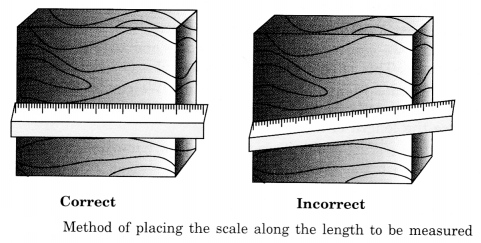
Measurement with a scale with broken ends
- Avoid taking measurements from zero mark.
- Use any other full mark of the scale, say 1.0 cm.
- Subtract the reading of this mark from the reading at the other end. For example, in Fig. 10.3 (6), the reading at starting mark is 1.0 cm and at the other end it is 6.5 cm. Therefore, the length of the object is (6.5 – 1.0) cm = 5.5 cm.
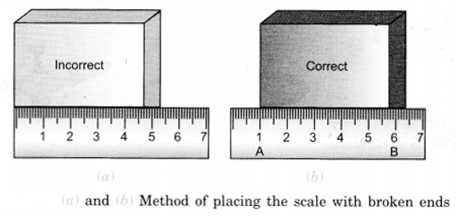
Correct position of the eye is also important for making measurement. Your eye must be exactly above the point where the measurement is to be taken as shown in Fig. 10.4. Position ‘A’ is the correct position of the eye. Note that from position A’, the reading is 1.0 cm. From positions ‘B’ and ‘C’, the readings may be different.

Least count: A scale is marked in centimetres and millimetres. With the scales of this kind we can measure correctly up to one millimetre, that is one-tenth of a centimetre. This is called the least count of a (15 cm) scale.
Measuring the length of a curved line: We cannot measure the length of a curved line directly by using a metre scale. We can use a thread or divider to measure the length of a curved line.
Motion: It is a state of objects in which they are moving, that is, they are changing their place with the changing time.
Rest: All the stationary objects which are not in motion, that is, do not change their place with time are said to be at rest.
Rectilinear motion: When the objects change their position with time along a straight line, this type of motion is called rectilinear motion.
Circular motion
- When a body moves in a circular path, its motion is known as circular motion
- Examples:
- motion of stone tied in a thread and whirled.
- motion of a blade of an electric fan.
- motion of second’s hand in a clock.
- In circular motion, the object remains at the same distance from a fixed point.

Rotational motion: Motion in which a whole body moves about an axis is called a rotational motion. Example: motion of a top.
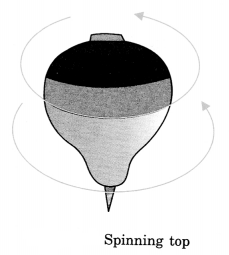
Periodic motion: Motion in which an object repeats its motion after a fixed interval of time is called periodic motion.
Examples:
- Oscillations of a pendulum.
- (Motion of a swing.
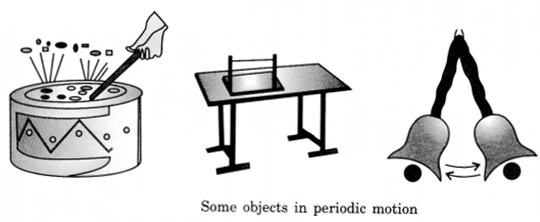
Combination of two or more types of motions: In some situations, the motion of an object may be a combination of two or more of the above mentioned types of motion.
Examples:
- Motion of a ball on the ground. Here, the ball is rotating about an axis but the axis itself is moving along a straight line. Thus, the ball executes a rectilinear motion as well as rotational motion.
- Motion of earth—earth executes rotations on its axis and also revolves around the sun.
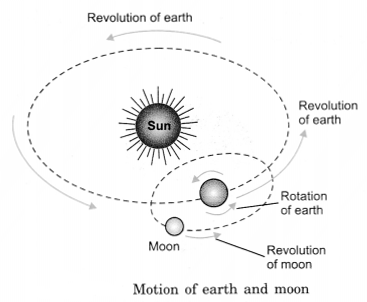
Unit of measurements
- It involves the comparison of an unknown quantity with some known quantity of the same kind.
- This known fixed quantity is called unit.
- The result of measurement is expressed in two parts. One part is a number; the other part is the unit of measurement.
Circular motion: When a body moves in a circular path, its motion is known as circular motion.
Distance: Measurement of gap between two points in certain units is called distance.
Measurement: Measurement means the comparison of an unknown quantity with some known quantity.
Motion: It is a state of objects in which they are moving that is, they are changing their place with time.
Periodic motion: Motion in which an object repeats its motion after a fixed interval of time is called periodic motion.
Rectilinear motion: When the objects change their position with time along a straight line, this type of motion is called rectilinear motion.
SI units: In October, 1960 the 12th general conference on weight and measures adopted the International system of units to maintain uniformity
all over the world. This system of units is called SI units.
Units of measurement: Measurement means the comparison of an unknown quantity with some known quantity. This known fixed quantity is called a unit of measurement.